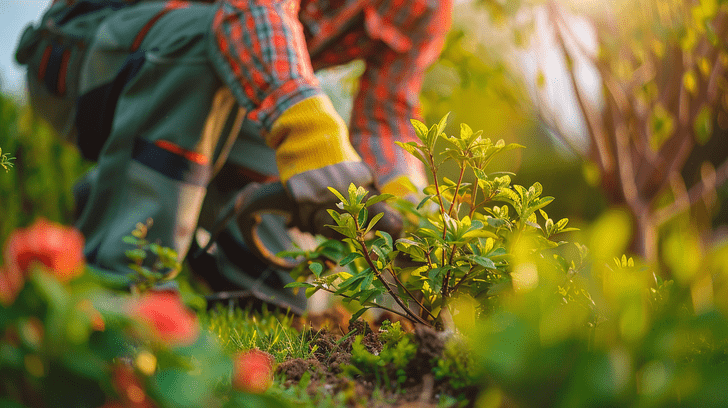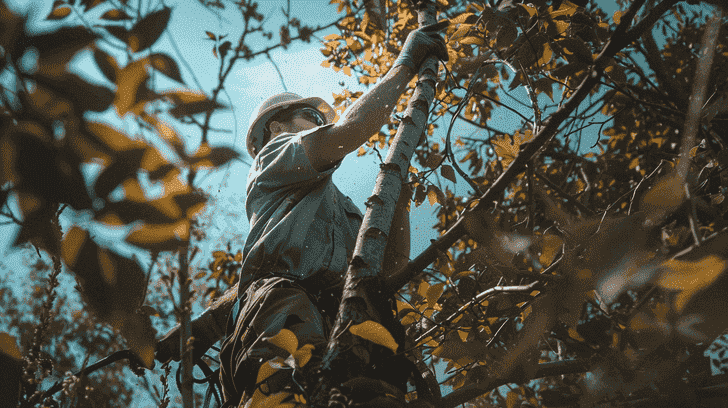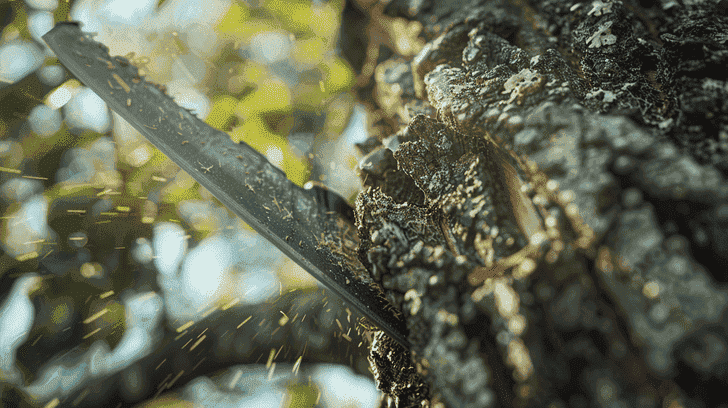Pruning Pitfalls: Learning From Bad Tree Pruning Examples
Avoid the pitfalls of bad tree pruning by steering clear of topping, which weakens trees and attracts decay. Also, watch out for lion’s tailing, which messes with the tree’s structure and aesthetics.
Over-thinning can strip branches of strength and expose them to harsh sunlight. Improper techniques like flush cutting hinder wound closure and affect tree health.
Timing matters too; winter pruning can harm trees and delay healing. Consider the species, as each type requires unique care.
Ignoring these factors can disrupt ecosystem balance and damage tree aesthetics. Learn the dos and don’ts to keep trees healthy and beautiful.
Common Mistakes in Tree Pruning
When it comes to tree pruning, you must avoid common mistakes like topping, Lion’s Tailing, and over-thinning. These practices can weaken the tree’s structure, lead to decay, and make it more susceptible to diseases and pests.
Topping
Improperly topping a tree is one of the most common mistakes made in tree pruning practices. When trees are topped, their branches are indiscriminately cut, leaving stubs behind.
This not only harms the tree’s aesthetics but also jeopardizes its health and structural integrity.
Improper topping disrupts the tree’s natural regrowth patterns, leading to weakly attached new branches that are prone to breaking.
To maintain tree health and appearance, it’s essential to follow pruning best practices. Instead of topping, focus on selective branch removal to promote healthy growth and maintain the tree’s form.
Lion’s Tailing
To maintain the health and appearance of your trees, avoid the common mistake of lion’s tailing during pruning practices.
Lion’s tailing refers to the improper shaping of trees through excessive thinning of inner foliage, leading to weak branch attachments and delayed response to wound compartmentalization.
This harmful pruning technique not only compromises the structural integrity of the tree but also results in aesthetic damage.
By steering clear of lion’s tailing and instead opting for proper pruning methods that promote strong branch structure and overall tree health, you can guarantee the longevity and beauty of your trees.
Over-Thinning
Avoid the common mistake of over-thinning your trees during pruning, as it can lead to detrimental effects on their health and appearance.
Over-thinning refers to the excessive removal of branches, resulting in sparse foliage and an imbalanced canopy. Here are three reasons why over-thinning can harm your trees:
- Branch Structure: Over-thinning weakens the tree’s branch structure, making it more susceptible to breakage during storms or heavy winds.
- Canopy Density: Excessive thinning reduces canopy density, exposing the tree to harsh sunlight and affecting its ability to photosynthesize effectively.
- Tree Health: Over-thinning can compromise the overall health of the tree by disrupting its natural growth patterns and depleting its energy reserves.
Improper Pruning Techniques
When it comes to improper pruning techniques, two key points to focus on are flush cutting and improper angle cuts.
Avoid cutting branches too close to the trunk, as it can lead to decay and disease.
Make sure to cut at the right angle to promote proper healing and growth in the tree.
Flush Cutting
Improper tree pruning often results in flush cutting, a practice that can be detrimental to the health and aesthetics of trees.
- Branch Collar and Pruning Cuts: Cutting too close to the trunk eliminates the branch collar, which is essential for proper healing.
- Tree Health and Wound Closure: Flush cuts hinder the tree’s ability to close wounds efficiently, leading to decay and potential infections.
- Proper Technique and Tree Vitality: By avoiding flush cuts and instead making proper pruning cuts outside the branch collar, you promote tree vitality and overall health.
Improper Angle Cuts
Proper tree pruning involves making precise cuts that maintain the branch collar intact, ensuring ideal healing and tree health.
When it comes to ‘Important Angle Cuts,’ it’s essential to focus on proper branch selection, correct pruning angles, avoiding bark damage, healthy wound closure, and achieving a balanced tree structure.
Important angle cuts can lead to slow healing, decay, and structural weakness in trees.
By understanding the right techniques, you can promote healthy growth and prevent harm to your trees.
| Key Point | Description |
| Proper Branch Selection | Choose the right branches to prune. |
| Correct Pruning Angles | Cut at appropriate angles for best healing. |
| Avoiding Bark Damage | Prevent injuries to the tree’s protective layer. |
| Healthy Wound Closure | Ensure wounds close effectively for tree health. |
Pruning at the Wrong Time
When it comes to pruning at the wrong time, you need to be mindful of the specific needs of your trees. Winter pruning can expose trees to harsh conditions, impacting their ability to heal properly.
Flowering trees, in particular, require careful timing to make sure you don’t inadvertently remove flower buds.
Winter Pruning
During the winter months, avoid pruning your trees to prevent unnecessary stress and potential damage. Winter pruning can harm trees due to the cold weather and dormancy period. Here are some reasons why you should steer clear of pruning during this time:
- Frost Damage Prevention: Pruning in winter can leave fresh wounds exposed to frost, increasing the risk of damage to the tree.
- Dormant Pruning Benefits: While trees are dormant in winter, pruning might interfere with the natural processes that help them survive the cold season.
- Cold Weather Pruning Considerations: Extreme cold can slow down the healing process of tree wounds, making them more susceptible to diseases and pests.
Flowering Trees
Avoid pruning flowering trees at the incorrect time to guarantee ideal blooming and growth. Pruning at the wrong time can disrupt the tree’s natural cycle, leading to reduced or delayed flowering.
Proper timing is essential to secure the health and beauty of your flowering trees. Understanding the specific flowering season of your tree species is vital for effective pruning techniques and overall tree maintenance.
Improper pruning can weaken the tree’s health, making it more susceptible to diseases and pests. It can also impact the tree’s aesthetic appeal, affecting your landscape design.
By following the correct timing for pruning your flowering trees, you can promote excellent tree health and enhance the beauty of your outdoor space.
| Pruning Techniques | Flowering Season |
| Proper timing is vital for effective pruning | Understanding the specific flowering season is essential |
| Improper pruning can weaken tree health | Correct timing enhances tree beauty |
| Pruning at the wrong time disrupts the natural cycle | Ideal blooming results from proper timing |
| Enhances tree health and resilience | Promotes excellent growth |
| Affects tree aesthetics and landscape design | Ensures tree’s overall well-being |
Lack of Consideration for Tree Species
When pruning trees, it’s essential to take into account the species you’re working with.
Conifers require different pruning techniques than deciduous trees, and fruit trees have their own unique requirements.
Neglecting to acknowledge these distinctions can lead to poor growth, disease susceptibility, and overall tree health issues.
Pruning Conifers vs. Deciduous Trees
Considering the specific characteristics and growth patterns of conifers and deciduous trees is essential when determining the appropriate pruning techniques.
- Evergreen vs. Deciduous: Evergreen conifers retain their foliage year-round, requiring different pruning approaches than deciduous trees that shed their leaves annually.
- Pruning Techniques: Conifers often need lighter pruning to maintain their natural shape, while deciduous trees might benefit from more aggressive pruning to encourage new growth.
- Tree Health: Improper pruning can stress conifers by removing too much greenery, impacting their health differently than deciduous trees.
Understanding these distinctions is important for ensuring the health and longevity of conifers and deciduous trees.
By tailoring your pruning methods to suit each tree type, you can promote optimal growth and vitality.
Fruit Trees
To properly prune fruit trees, it’s essential to take into account the specific characteristics and requirements of each tree species.
Different fruit trees have varying needs when it comes to pest control, sunlight exposure, proper spacing, disease prevention, and fertilizer application.
For example, apple trees benefit from annual pruning to maintain an open canopy for sunlight penetration, aiding in fruit ripening and reducing disease risk.
Proper spacing between peach tree branches allows for good air circulation, minimizing fungal infections.
Regular pruning of citrus trees not only shapes the tree but also aids in pest control by removing infested branches.
Understanding these species-specific requirements is vital for promoting healthy fruit production and overall tree vigor.
Environmental and Aesthetic Impacts
When poorly pruned, trees can lose their natural beauty and disrupt the harmony of the landscape. Improper pruning practices can also harm the ecosystem by affecting biodiversity and overall environmental health.
It’s vital to understand the lasting impact that bad pruning techniques can have on both the aesthetics and the environment surrounding trees.
Effects on tree aesthetics and landscape design
Improper tree pruning can greatly impact the aesthetics and design of your landscape, potentially diminishing the overall beauty and appeal of your outdoor space.
When considering the effects on tree aesthetics and landscape design, several key aspects come into play:
- Tree Canopy: Poor pruning can lead to a sparse or misshapen canopy, disrupting the natural beauty and fullness of the tree.
- Branch Structure: Incorrect pruning techniques can result in unbalanced branch distribution, affecting the overall visual appeal of the tree.
- Visual Balance: Improper pruning may disrupt the visual balance of the tree within the landscape, creating an unharmonious appearance that detracts from the overall design.
Ensuring proper tree pruning techniques is essential in maintaining tree form and landscape harmony.
Impact on ecosystem health and biodiversity
Impact on ecosystem health and biodiversity is essential when considering the environmental and aesthetic implications of improper tree pruning practices.
Improper pruning can disrupt ecosystem balance and biodiversity by affecting the natural habitats of various species. It can hinder habitat preservation and restoration efforts, limiting the resources available for wildlife.
Wildlife conservation and management are also impacted, as the altered tree structures may not provide adequate shelter or food sources. Additionally, improper pruning practices can hinder plants’ and animals’ ability to adapt to climate change, affecting their survival.
To mitigate these issues, it’s important to prioritize sustainable practices and stewardship when caring for trees, ensuring that pruning methods support ecosystem health and biodiversity for the benefit of all.
Long-term consequences of bad pruning practices for the environment
Utilizing improper tree pruning techniques can have lasting detrimental effects on the environment, impacting both the aesthetics and ecological balance of an area.
When bad pruning practices persist, they can lead to significant long-term consequences:
- Ecological damage: Improper pruning can disrupt the natural balance of an ecosystem, causing harm to various plant and animal species.
- Habitat loss, biodiversity decline: By removing essential parts of trees haphazardly, bad pruning practices can result in the loss of habitats for wildlife and contribute to a decline in biodiversity.
- Ecosystem disruption, environmental degradation: Bad pruning can disrupt the intricate web of interactions within an ecosystem, leading to overall environmental degradation, impacting not only the trees but also the surrounding flora and fauna.
Conclusion
Avoiding common tree pruning mistakes is essential to maintaining the health and beauty of your trees.
Did you know that improper pruning accounts for 80% of tree failures in urban areas? By learning from bad tree pruning examples and following proper techniques, you can secure the longevity and vitality of your trees.
Remember to always consider the species of tree, timing of pruning, and environmental impacts to achieve the best results.
Happy pruning!







